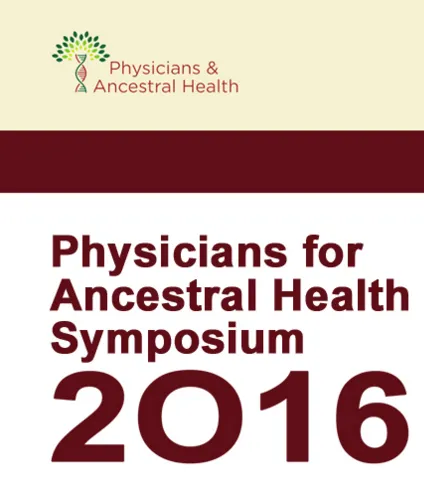
Physicians and Ancestral Health 2016
We had a great winter retreat in Arizona this winter, and enjoyed a wide variety of talks. All of which directed themselves one way or another toward a health, ancestral-based, lifestyle.
Jeffrey Gerber, MD, Denver’s Diet Doctor, suggested that everyone with cardiovascular disease (hypertension, history of heart attack) has some degree of diabetes, whether or not they have yet been diagnosed. Diagnose with a 2-5 hour glucose tolerance test, paying close attention to insulin. Fasting insulin should be
Darryl Edwards, the Fitness Explorer, described seven steps to take to overcome the slow march towards inactivity we’ve seen in the digital age: 80% of children lead relatively inactive lives. Fitness is best achieved through varied and challenging activities, staged outside, with a mind toward greater capacity for ordinary as well as extraordinary tasks. (Yes, carry both shopping bags at once! … or work towards that.) And while you’re at it, if you can make it fun, your nervous system reaps a great benefit.
Daria Schooler, MD, retired neurosurgeon, taught us the difference between the milk of A2 cows, an ancient breed, and the relative newcomers, A1 cows, around for only the last 2000 years. The vast majority of milk in the US comes from A1 cows, the A1 casein notorious for digesting to BCM7, or beta-caseomorphine 7, which is extremely hazardous in the presence of a leaky gut, or intestinal permeability. Before you congratulate yourself that you don’t have leaky gut (newborns, celiac disease, inflammatory bowel disease), think again: every time you exercise, you have a leaky gut for one to several hours following. No more chocolate milk after a workout! BCM7 is neuroactive (mood and behavioral changes) and promotes the oxidation of LDL particles (which we learned repeatedly over the weekend, is probably where the money is in terms of predicting heart disease risk) and increases the risk for auto-immune type 1 diabetes. (For those drinking whey protein after a workout: whey protein should be casein-free, but is not always. Check your supplier.)
Dawn LeManne, MD, integrative oncologist, talked to us about the roles of intermittent fasting and carbohydrate restriction in cancer therapy. She reminded us that “cancer” is a vast and complex topic, and each cancer can be different. Commonly, cancers are unable to burn fat for fuel, which has stimulated an interest in a ketogenic diet for cancer. Sadly, cancers are also very adaptable in their zeal to survive, so a ketogenic strategy is unlikely to be successful on a permanent basis. But here’s the good news, just two items from her information-dense talk. First: post-menopausal women with breast cancer, who are overweight at the time of diagnosis, have a 40-90% reduction in 5-year recurrence if they decrease their carbohydrate intake by 27 grams a day. That’s one less banana!! That’s equal to or better than chemotherapy and tamoxifen combined… and doesn’t work for everyone. A topic of current research interest and possible application for colon cancers and brain cancers (glioblastoma multiforme.) Secondly: fasting around a chemotherapy treatment enhances the chemo’s effectiveness and reduces side effects or harm to normal cells! Ideally, you limit yourself to water for 24 hours before and after, or at the very least, just 12 hours before and 4 hours after.
Bryan Barksdale, MD-PhD student, talked to us about the use of ketones in traumatic brain injury (TBI). It’s not just football players and veterans, in fact chronic disability, that’s severe TBI, affects 1% of the US population. Each injury is different, but the damage results from some combination of increased intra-cranial pressure resulting in decreased blood flow to the brain and subsequent damage to the cells and the careful balance they maintain with the fluid around them. It turns out that ketones and ketogenic diets are quite neuroprotective, addressing many if not all of the aspects of neurological damage following trauma. If I ever have a brain injury, please make sure I’m not fed for a day, then fed a ketogenic diet for a week, with omega-3 fatty acids. Then you can re-feed me with more food and all the nutrients I’ve needed.
Carol Loffelman, MD, understands music well as a musician and an anesthesiologist. Babies in the womb are able to hear just half way through the pregnancy, and start making music themselves soon after birth. I know we call it crying, but those wails are a babe’s first expressions! Music can be soothing and rhythm-inducing: useful both in anesthesia and working with patients on ventilators. Music is deeply imbedded in our beings and brains at a primitive level. When US Representative Gabrielle Giffords was recovering from her brain injury, she could sing words before she could speak them!
I wrapped up the first day talking about bio-identical hormone therapy. Referring to evolution, yes it makes sense that the physiological process of childbirth stops at a certain point in a woman’s life. She can help the community as an elder rather than be a drag on resources as an elderly mother. Turning from the species to the individual: as a single person, I can benefit greatly from restoring some of those hormones lost at menopause. With properly prescribed and monitored bio-identical hormones (BHRT), a post-menopausal woman can derive great benefit with little or no increased risk. (The risks of hormones are entirely from non-bio-identical hormones taken orally rather than through the skin. Look for a full article on this site soon!)
And that was just the first day! More highlights forthcoming over the next month.

